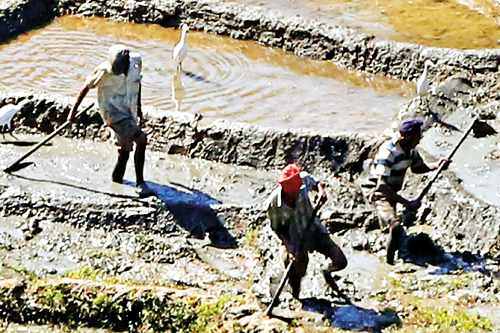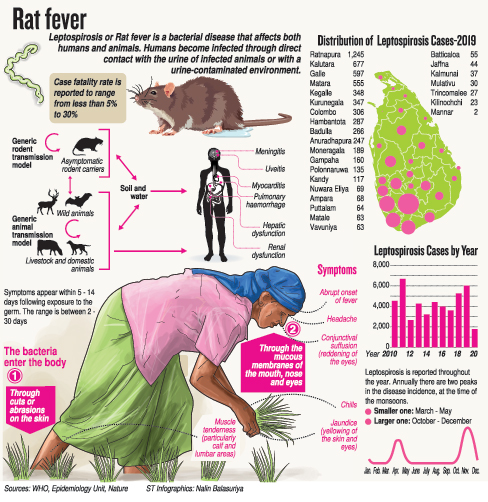News
Rat fever raises its head again

Danger in the form of rat fever lurks in the fields for the farmers. Pic by M.A. Pushpa Kumara
Heart-warming images of vast expanses of land with farmers knee-deep in muddy waters ploughing their fields, as rains lash Sri Lanka.
In those waters, danger lurks for these humble sons of the soil.
Leptospirosis (rat fever or mee una) is on the rise, warns Consultant Physician Dr. Wimalasiri Uluwattage of the Karapitiya Teaching Hospital, explaining that not just rats but also cattle and dogs can harbour this infection.
The most vulnerable to rat fever are farmers, fresh-water fishermen, gem-miners, plantation workers, those cleaning canals and drains, whitewater rafters and even groups like drug addicts who may gather in abandoned marshy lands.
When people with rat fever seek treatment, watch out for bleeding into the lungs (pulmonary haemorrhage), is Dr. Uluwattage’s strong plea, as he explains that even though rat fever is not new to Sri Lanka, having been identified as far back as 1959, those days the complications arose due to kidney and liver involvement.

Dr. Wimalasiri Uluwattage
“But now there is the new complication of pulmonary haemorrhage that has come about due to a change in the behaviour of the spirochetes, the spiral-shaped bacteria which cause rat fever,” he says.
Dr. Uluwattage explains that earlier the most severe form of rat fever was Weil’s Disease involving the classical ‘triad’ of liver damage (jaundice), kidney (renal) failure and bleeding (haemorrhage) into the gut, urine or mouth.
However, that changed when in 1995, death due to a severe form of bleeding into the lungs was detected in Nicaragua, followed by South Korea and China.
There was an epidemic of rat fever in Sri Lanka in 2008, but no lung complications were detected in patients in the Raja Rata in the north central regions. However, the team which treated 459 patients suffering from rat fever at Karapitiya in the south found through autopsies that of 25 deaths, 21 were due to pulmonary haemorrhage.
“This was a significant finding. When there is major lung involvement, the patient needs acute and intensive care in the form of respiratory support and supplementary oxygen through intubation and ventilation,” says Dr. Uluwattage, reiterating that the condition of the patient is serious. Chest X-rays should be taken and would indicate cotton wool shadows in the lungs.
 Looking at the regional scenario, he says that rat fever is usually highly-prevalent in the Wet Zone districts of Colombo, Gampaha, Kalutara, Galle, Matara, Kegalle, Matale and Ratnapura, while in the Dry Zone it raises its head during the rainy season or after floods.
Looking at the regional scenario, he says that rat fever is usually highly-prevalent in the Wet Zone districts of Colombo, Gampaha, Kalutara, Galle, Matara, Kegalle, Matale and Ratnapura, while in the Dry Zone it raises its head during the rainy season or after floods.
In 2016 and 2017, the Karapitiya Hospital which treats patients from all over the Southern Province saw many people succumbing to rat fever.
When Dr. Uluwattage arrived at Karapitiya, he sat down with the Consultant Nephrologist and Consultant Physicians and studied the case histories. They saw a pattern and identifying some features, zeroed in on how to predict the development of pulmonary haemorrhage.
“It was linked to the pathophysiology of the patient and how the immune system responded to the infection. The usual pattern was Days 1-7, it was the febrile phase and Days 8-21, the immune phase. The bad effects of the immune reaction which could affect the organs causing kidney or lung damage, came after the 5th or 6th day.
Delving deep into the lungs, he says that the overt and severe reaction of the immune system affected the alveoli – which are like midi gedi or grapes, forming clusters at the very end of the respiratory tree. These alveoli are an important part of the respiratory system and the exchange point for oxygen and carbon dioxide to and from the bloodstream. When they get damaged, there is severe bleeding all over the lungs, reducing the gas exchange and causing hypoxia.
Hypoxia deprives life-giving oxygen to tissue, says Dr. Uluwattage, adding that now there is a treatment modality which is successful in saving lives.
| How one can get rat fever | |
| This infectious disease is caused by bacteria called leptospires found in the kidneys of rodents, livestock (cattle and buffalo), canines and also wild mammals. The bacteria are transmitted directly or indirectly from animals to humans.While some of the animals are natural hosts, when they excrete the bacteria through their urine and humans are exposed to contaminated water, soil or food, humans may become ‘incidental’ or ‘accidental’ hosts. The bacteria may enter humans through wounds or lesions in the skin or nasal, oral or eye mucous membranes. Symptoms The symptoms of rat fever appear within 5-14 days of exposure to the bacteria and range from mild flu-like illness to serious and sometimes fatal disease. These symptoms include high fever, severe body aches, severe headaches, prostration (inability to get up), myalgia (pain in the muscles particularly neck, back and calves), shortness of breath and rapid breathing (hathiya) in the wake of which there would be coughing out of blood. How to prevent rat fever?
|
| Therapeutic Plasma Exchange saves lives | |
 Consultant Transfusion Physician Dr. Teshanthi Walivita who carries out the Therapeutic Plasma Exchange procedure for rat fever patients at the Karapitiya Hospital The effective treatment in saving rat fever patients with severe lung haemorrhage is ‘Therapeutic Plasma Exchange’ or plasmapheresis, the Sunday Times learns. This has “drastically” reduced the death rate among patients from 75% to 25%, points out Dr. Wimalasiri Uluwattage. Used in the treatment of auto-immune diseases, the patient’s plasma is removed and replaced with fresh plasma, it is understood. “Small amounts of blood are gradually removed from the patient’s body through an inserted needle or central line catheter and circulated through a machine that introduces a plasma substitute to his/her own blood cells (red cells, white cells and platelets). Thereafter, the blood, from which about 70% of the affected proteins (antibodies) have been removed, is re-channelled into the patient with fresh plasma,” he says.
 A patient undergoing Therapeutic Plasma Exchange |


